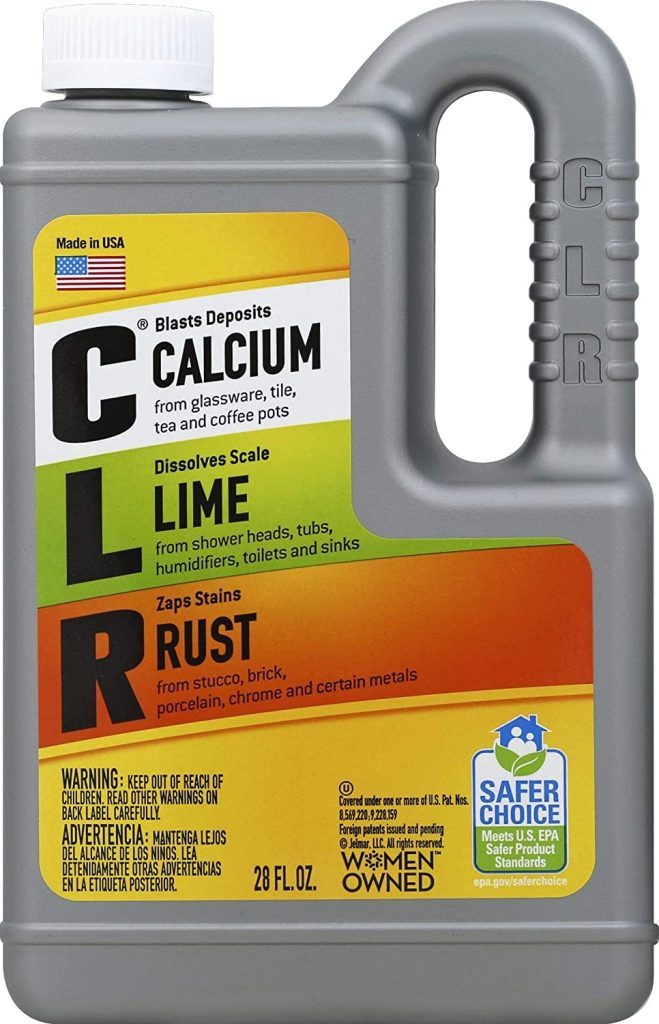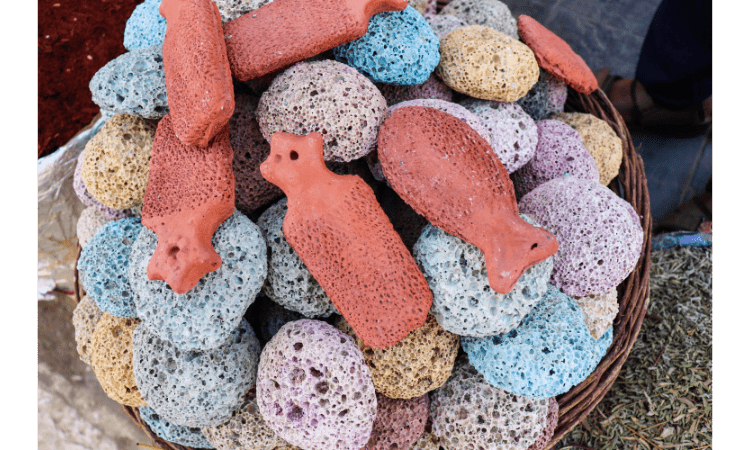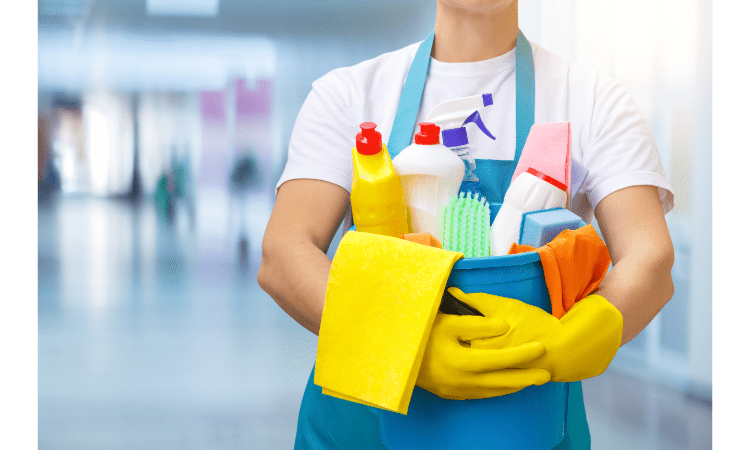
Hard water spots are unsightly and embarrassing. Even worse, they can damage fixtures and hardware, shortening the life of your toilet and costing you money. Fortunately, there are a number of options for removing hard water stains from your toilet. In this article, we’ll explain how to use baking soda and vinegar, how to scrub with sandpaper, which commercial cleaners work best for this task, and more.
Baking soda and vinegar

This is a simple and effective method for removing hard water stains from your toilet bowl. To start, mix equal parts white vinegar and baking soda to create a paste. The acidic properties of the vinegar will work to break down the stains, while the abrasive properties of the baking soda will help to scrub them away.
Next, apply the paste to the stains in your toilet bowl, making sure to cover the entire area. Allow the paste to sit for at least 30 minutes, as this will give it time to work on breaking down the stains.
After the paste has had time to sit, use a toilet brush to scrub the area. The baking soda in the paste will act as a gentle abrasive, helping to scrub away the stains. Be sure to scrub thoroughly, paying extra attention to any particularly stubborn stains.
Finally, flush the toilet a few times to rinse away any remaining paste and stains. You may want to repeat the process if necessary until the stains are completely removed.
It’s important to note that, when using vinegar, you should avoid mixing it with other cleaning products, especially those that contain bleach, as it can release dangerous fumes. Also, if you have a septic tank, avoid using vinegar and baking soda as it can harm the good bacteria in the tank.
Lemon juice

Lemon juice is another acidic substance that can be used to remove hard water stains from your toilet bowl. The acidic properties of lemon juice work to break down the stains and make them easier to scrub away.
To start, simply apply lemon juice directly to the hard water stains in your toilet bowl. You can use fresh lemon juice or store-bought, both will work. Let the lemon juice sit on the stains for 15-20 minutes. This will give it time to work on breaking down the stains and making them easier to remove.
After the lemon juice has had time to sit, use a toilet brush to scrub the area. The acid in the lemon juice will help to break down the stains, while the bristles of the brush will work to scrub them away. Be sure to scrub thoroughly, paying extra attention to any particularly stubborn stains.
Finally, flush the toilet a few times to rinse away any remaining lemon juice and stains.
It’s important to note that, if the stains are too old, or if the toilet bowl is in bad condition, lemon juice alone may not be enough to remove them. In that case, you may need to use a more abrasive method or a commercial cleaner. Additionally, if you have a septic tank, avoid using lemon juice as it can harm the good bacteria in the tank.
Also Read: How to neutralize bathroom odours
Very fine steel wool

- Use a good quality brand of steel wool. I like to use the 3M brand, which is known for its high-quality products and excellent customer service.
- When cleaning your toilet, be sure to use white vinegar instead of lemon juice or other less acidic liquids. Vinegar is also great for cleaning up after any hard water stains that you may have left behind when using the method above!
CLR:

CLR (Calcium, Lime and Rust remover) is a commercial product that can be used to remove hard water stains from toilets. CLR is specifically designed to remove the minerals that cause hard water stains, making it an effective option for tackling tough stains.
To use CLR, begin by carefully reading the instructions on the product and ensuring that it is safe to use on your particular toilet bowl. Next, apply CLR to the hard water stains, making sure to cover the entire area.
Allow the CLR to sit on the stains for the recommended amount of time on the product, usually between 5-10 minutes. This will give it time to work on breaking down the stains and making them easier to remove.
After the CLR has had time to sit, use a toilet brush to scrub the area. The CLR will help to break down the stains, while the bristles of the brush will work to scrub them away. Be sure to scrub thoroughly, paying extra attention to any particularly stubborn stains.
Finally, flush the toilet a few times to rinse away any remaining CLR and stains.
It’s important to note that, CLR is a strong chemical and should be used with caution. It’s also important to use gloves and work in a well-ventilated area, to avoid inhaling the fumes. Additionally, if you have a septic tank, avoid using CLR as it can harm the good bacteria in the tank.
Also Read: How to keep bathroom safe for disabled or older adults
Toilet bowl cleaner:

Many commercial toilet bowl cleaners are specifically designed to remove hard water stains. These cleaners contain chemicals that are formulated to break down and remove the minerals that cause hard water stains.
To use a toilet bowl cleaner, begin by carefully reading the instructions on the product and ensuring that it is safe to use on your particular toilet bowl. Next, apply the cleaner to the hard water stains, making sure to cover the entire area.
Allow the cleaner to sit on the stains for the recommended amount of time on the product, usually between 5-10 minutes. This will give it time to work on breaking down the stains and making them easier to remove.
After the cleaner has had time to sit, use a toilet brush to scrub the area. The cleaner will help to break down the stains, while the bristles of the brush will work to scrub them away. Be sure to scrub thoroughly, paying extra attention to any particularly stubborn stains.
Finally, flush the toilet a few times to rinse away any remaining cleaner and stains.
It’s important to note that, when using a commercial cleaner, you should always wear gloves and work in a well-ventilated area to avoid inhaling the fumes. Additionally, always read the product’s label and instructions to ensure that it is safe to use on your specific toilet bowl and that it is compatible with your septic system before using it.
Also Read: Best Laundry tips that most people are not aware of
Pumice stone:

A pumice stone is a natural volcanic rock that can be used to scrub away hard water stains. It is a gentle abrasive that can remove stains without scratching the porcelain surface of the toilet bowl.
To use a pumice stone, wet the stone and the area of the toilet bowl where the stains are located. Gently rub the pumice stone over the stains, being careful not to scratch the surface of the toilet bowl. You may need to apply a little pressure, but be careful not to press too hard.
As you scrub, the pumice stone will remove the stains, and the water will help to keep the surface of the toilet bowl lubricated, preventing scratches.
Continue scrubbing until the stains are removed, then flush the toilet a few times to rinse away any remaining debris.
It’s important to note that, when using a pumice stone, you should always wear gloves and work in a well-ventilated area to avoid inhaling the dust. Additionally, be careful not to rub the pumice stone too hard, as it can scratch the porcelain surface of the toilet bowl. Also, pumice stone is not recommended for use on colored or painted toilet bowls.
Commercial Cleaners

Commercial cleaners can be expensive, and they may not be very effective. Commercial cleaners can also have harmful side effects for your health, the environment and even your toilet. Toilets are made of porcelain or vitreous china (which is made of high-quality clay). Many household cleaners are designed to remove stains from other materials, like clothing and countertops. These chemicals can damage the surface of a toilet bowl over time. This can cause discoloration or cracks that will leak water into your bathroom flooring when you flush the toilet!
Call a professional:

If the hard water stains are too stubborn, or if you don’t want to use any chemicals, you can always call a professional to remove them for you. Plumbers or cleaners are well equipped to handle hard water stains and can remove them quickly and effectively.
When calling a professional, make sure to explain the problem and the severity of the stains to them, so that they know what to expect. They will have specialized tools and equipment to remove the stains and will be able to do the job in a short amount of time.
They may use specialized solutions and equipment such as pressure washers, specialized brushes, and chemicals to remove the stains. They will also have the experience and knowledge to safely remove the stains without damaging the toilet bowl or septic system.
Additionally, professional cleaners can also offer preventative measures to keep the stains from reappearing in the future and can provide regular cleaning services to keep the toilet bowl looking clean and new.
It’s important to note that, when hiring a professional, you should always check their references, ask for their credentials, and ensure that they are insured and licensed. Additionally, ask them about the methods and products they will use, to ensure that they are compatible with your septic system.
Conclusion

In conclusion, hard water stains can be unsightly and difficult to remove, but with the right tools and techniques, you can easily get your toilet looking brand new again. Whether you choose to use vinegar and baking soda, lemon juice, CLR, a commercial toilet bowl cleaner, a pumice stone or call a professional, the key is to take action as soon as you notice the stains and to use the method that best suits your needs and preferences.
It’s also important to remember that prevention is key. You can prevent hard water stains from forming in the first place by regularly cleaning your toilet bowl, and by using a water softener if you have hard water at home. Additionally, you should also avoid using abrasive cleaning products, and make sure to always read the instructions and warning labels on any product you use.
By following these tips, you can easily keep your toilet looking clean and stain-free, and enjoy a sparkling bathroom.











